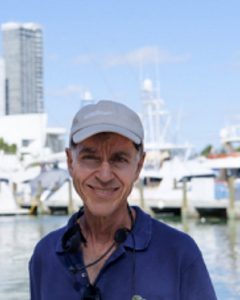|
Getting your Trinity Audio player ready...
|

Behind the phenomenal growth of the Burdine’s department stores in the 1920s was, of course, Roddey Burdine, a superb merchandiser and marketer with a hands-on approach to his employees and customers. Typically, Burdine would walk the floors of his stores with George Whitten, his top assistant and lifetime friend at his side, taking notes in his ever-present notebook on Roddey’s suggestions and approaches to displaying and arranging goods. It was Whitten who, in the aftermath of Roddey’s untimely death, would take the helm of Burdine’s.
Another side of Roddey’s life was his deep commitment to his community, a place he loved and one he believed possessed an unlimited future. This commitment deepened as the year’s unfolded. As chairman of the Citizens Committee, a blue-ribbon group comprised of prominent Miamians, Roddey managed the campaign that led to the adoption, in 1921, of a new commission-manager form of government, an entity considered more efficient than the mayor-council for the governance of a rapidly growing city.
Roddey was also one of the organizers of a Better Business Bureau for Miami, an important organization given the mounting number of complaints over questionable real estate transactions. Burdine’s leadership of a successful drive by the city of Miami, at the height of the real estate boom, to annex Coconut Grove, Silver Bluff, Allapattah, and Lemon City, represented one of his most important efforts in civic affairs. When Miami’s voters overwhelmingly approved annexation in September 1925, the city’s physical dimensions increased nearly five-fold and its population soared. “Nothing greater has ever happened in the history of Miami,” Roddey exclaimed.
At the outset of the 1930s, Roddey was appointed chairman of the Florida State Racing Commission, a body in need of complete reorganization. After eighteen months at the helm, Burdine’s efforts bore fruit in an effective overhaul of the commission. At the same time, he was a director of the Community Chest, the predecessor of today’s United Way and the area’s most important eleemosynary group.
Roddey’s life-long interest in sports manifested itself in his preeminent role in the creation of the Miami Country Club, a facility that spread over 130 acres of green space on the site of today’s Miami Civic Center. With its 18-hole golf course, the Miami Country Club became one of the city’s premier golfing facilities from the mid-1920s till the 1950s. Its annual tournament attracted the country’s greatest golfers.
Roddey Burdine was instrumental in the creation of the Palm Festival football classic in the early 1930s, to promote tourism and provide visitors with another popular attraction. The Palm Festival soon segued into the Orange Bowl Classic football game on New Year’s Day.
In the meantime, the store suffered from the economic downturn of 1926, as the boom dissipated and a mighty hurricane smashed into Greater Miami. Among the areas suffering the heaviest devastation was downtown Miami. Always concerned over the well-being of his employees and Miamians, in general, Roddey distributed through his store 50,000 free garments to storm victims
The Miami area and other parts of Florida slipped into an economic depression three years before the rest of the nation, after the collapse of the real estate boom and the ruinous hurricane of 1926. Although Burdine’s sales revenue fell, it continued to turn a profit while undertaking an extensive remodeling of the downtown store. The firm also opened another, though short-lived store, in a stunning Streamline Moderne building, on Biscayne Boulevard. In the same year, Burdine’s introduced “Sunshine Fashions,” its distinctive brand of warm-weather wear, which was enthusiastically embraced by visitors and brought the store an ever-larger national following.
By the mid-1930s, Burdine’s financial picture had improved significantly. The firm’s business was now the tenth largest of any department store in the U.S. The spectacular opening of a beautiful Art Deco-styled Burdine’s store on Miami Beach’s fashionable Lincoln Road on the night of January 10, 1936, drew thousands, including a bevy of models flown in from New York City.
Roddey Burdine, however, was not present for the event. He was suffering from undulant fever, an illness acquired from imbibing unpasteurized milk from cows stricken with Bang’s disease. Its symptoms are extreme fatigue, lingering fever and inflammation of the brain. Roddey Burdine died from the malady in February 1936. He was 48. Miami’s populace was shocked by the news of his death, for he was one of the city’s most revered citizens. In the day’s following his death, Miami’s newspapers devoted several pages to the saga of Roddey Burdine. The Miami Herald observed: “Throughout the length and breadth of the city persons who had been his friends, who had been his customers, those too who had been his competitors were proclaiming Roddey Burdine as the ‘Merchant Prince of Miami.’”
Two years later, the city dedicated its new football stadium, built by the federal Public Works Administration, to the memory of Roddey in a stirring ceremony preceding a football game between the University of Miami and the University of Georgia. Roddey Burdine Stadim, as it was known until the Miami City Commission renamed it the Orange Bowl in 1950, would touch more persons in a greater variety of ways than any other structure in Miami. At the same time, the department store Roddey placed on the path of greatness would ultimately expand throughout the Sunshine State. For a time, both institutions, the stadium and the store, bore the Burdine name, a fitting tribute to Roddey Burdine, who impacted the lives of untold numbers of Miamians.
Paul S. George, Ph.D., serves as Resident Historian, HistoryMiami Museum. He conducts history tours throughout the County and even beyond for HistoryMiami. Dr. George also leads Little Havana tours as part of Viernes Culturales, a monthly celebration, every third Friday, of the culture and history of that quarter.






Comments are closed.